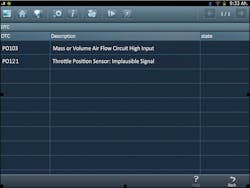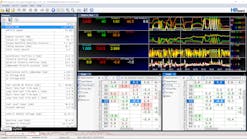Tool Q&A: Tools to use to diagnose stalling engines
Q: A customer complains of their vehicle stalling when coming to a stop. The engine rpm is erratic and the car stalls near idle. What do you do, and what tool do you use?
A: Assuming the technical service bulletins have been checked, the first step is to scan the vehicle for diagnostic trouble codes (DTCs). Veteran technicians agree that scan tools have become much faster and can diagnose the majority of stalling issues.
Victor Rivilla, director of marketing at Launch Tech USA, offers the example of diagnosing a 2007 Audi A3 that is stalling. The scan tool finds the following DTCs stored: P0103/16487 and P0121/16505. The P0103 will indicate mass or volume air flow circuit high input. The P0121 will indicate throttle position sensor, an implausible signal (See Fig. 1).
From the VAG repair manual, we learn the malfunction "P0103/16487" is set as soon as the signal voltage rises above 5V for longer than 0.5 seconds with engine speed below 2000 RPM, Rivilla notes (See Fig. 2).
The malfunction "P0121/" is set at a coolant temperature of over 70 degrees C (158 degrees F), with engine speed between 1,500 rpm and 3,500 rpm for longer than two seconds and an engine load over 66 percent found via the mass air flow sensor signal, as soon as the sensor signal voltage is less than 0.96 volts.
To "see" and check for the above, one can use a scan tool to view this data without needing to know the proper channel ID (if running the latest VW/Audi software from Launch). Simply select “Control Units/ Engine Electronics/ Advanced Measurement Data” and you will be able to view the above as it occurs.
To address the first DTC, Rivilla advises to check the mass air flow (MAF) sensor for dirt or fluid of any sort. Also, check to see if there is a solid connection between the connector and the sensor and if there is any corrosion.
For the second DTC, check the throttle position sensor harness for any signs of damage or contamination by debris or dirt and for any connection issues. Clear the DTCs and test drive.
The two DTCs are probably related, according to Phil Fournier, president of Phil’s Auto Clinic, St. Hemet, Calif. and instructor at Mt. San Jacinto College. When the MAF measures a high voltage signal, the PCM expects to see the TPS reflect a corresponding throttle at wide open throttle (WOT) and it does not; hence, the implausible signal. Chances are very good it is one issue only, Fournier notes. This is a huge reason why it is worthwhile for customers to pay for diagnosis as opposed to a “code read” which results in hanging parts for codes that are “performance codes” and not “component codes.”
Q: The car is exhibiting rich running conditions and experiencing lower than normal and/or erratic boost. Additionally, the vehicle seemingly stalls upon deceleration. What do I do?
A: Again, we scan the vehicle for DTCs, according to Rivilla. In this case there is no “check engine” light, but the ECU has three DTCs stored: P0172, system too rich bank 1; P2188, system too rich at idle; and P0238, turbo boost sensor circuit: high.
Again, it is very easy to blame the issues on a faulty MAF sensor, but with the part running well over $300, it is prudent to be sure and not simply throw parts at the problem. Again, with a scan tool, one can check live PID and sensor data. The procedure is the same as in the first case.
There is no need to know channel IDs and measuring block information, Rivilla notes. Check the MAF waveforms – are there any operational issues both at idle and at wide open throttle? How about the MAP sensor, which should drop after WOT? If it remains constant, this is an indicator of a faulty sensor. Replace the sensor if needed and view sensor waveform again. If everything looks good, clear DTCs and test drive.
Q: Will the scan tool always correctly diagnose the problem?
A: Veteran technicians claim scan tools will correctly diagnose most stalling problems, but there are situations where other tools are needed.
Bernie Thompson, president of Automotive Test Solutions (ATS), notes that a delay can occur in data transmissions which can hide the root cause of the stalling problem or lead you in the wrong direction. As the engine is stalling the entire data sets (sensor readings) are in change. These data sets are linked together in chains that indicate the physical changes that are read by the sensors. If you see a piece of the chain in the scan tool data stream fail, this may not be at the start of the chain but somewhere in the middle. With the delay in all data transmissions, it may be difficult to see the root cause.
Yet another problem for the scan tool is the way that a programmer writes the code to set DTC, Thompson notes. In order for a DTC to set, a threshold or set point must be crossed for a given period of time. If this does not occur, no DTC will set. However, the way the program is written, the wrong DTC may set. This may be due to a threshold against time being broken, not at the root cause of the problem, but somewhere in the middle of the chain.
An oscilloscope, when connected to the vehicle, will provide the actual electrical inputs and outputs to the engine control module, Thompson says (See Fig. 3). This data will be in real-time which allows the technician to see the chain of events that caused the engine to stall. By analyzing which one of the waveforms failed first, the actual failure can be determined.
Q: How do I use the oscilloscope to diagnose a stalling vehicle?
A: The technician will be required to follow a fault code flow chart if a relevant fault code is present or, armed with his knowledge of the system, he will begin to test and measure components of the engine management with an oscilloscope that could be responsible for the customer’s symptom, notes Richard Boyd, sales support manager at Pico Technology.
Boyd offers the example of a gas engine stalling when stopping at junctions but no fault codes evident. A description of the engine idle control system is required and a list compiled of possible components that could produce the stalling. From this list, the technician may decide to test the oxygen sensor, air flow meter and throttle position sensor.
Using the oscilloscope gives the technician the advantage of monitoring in real-time the actual live signals and compare them to the processed data from the scan tool (See Fig. 4).
Q: Are there other benefits to using an oscilloscope in this situation?
A: Yes, notes Boyd. Once connected to the components, the technician is able to look at the cause and effect of various sensors on the idle control system. A wiggle test is such a simple yet effective technique when looking at signals that may be interrupted due to wiring failures, connection issues and heat damage.
The oscilloscope can also be used during road tests when most intermittent faults occur, allowing the technician the same high speed capture ability under the operating conditions reported by the customer. The oscilloscope can record the signals above and when the fault occurs. The technician is able to pause and play back the captured data, zoom, measure and evaluate the signals to conclude a diagnosis as to why the vehicle may have stalled.
Boyd notes the oscilloscope will provide proof of component failure with supporting literature of before and after fix that will deliver confidence in the repair.
Have questions? Need answers? Email [email protected] to have your questions answered in this column.
For additional information on diagnosing stalling vehicles, read articles by Bernie Thompson of Automotive Test Solutions (VehicleServicePros.com/11292624) and Richard Boyd of Pico Technology (VehicleServicePros.com/11292607).


